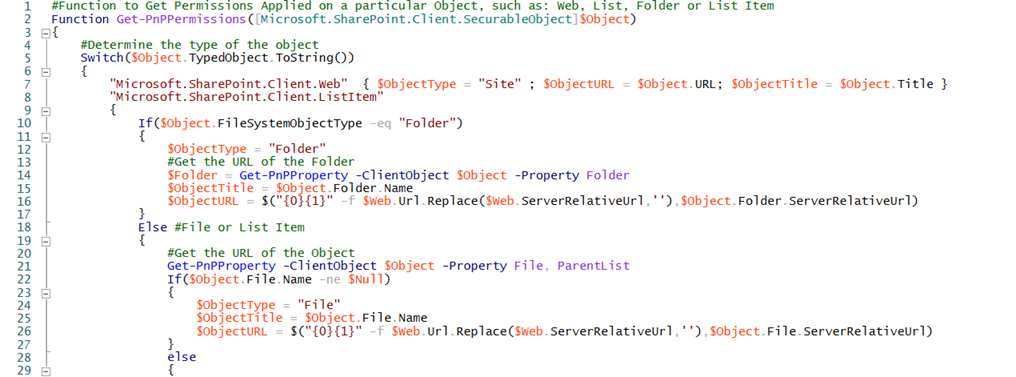I was recently asked by a client to look for a PowerShell script that would export the permissions for all of the files and folders within each of their site collection so they can perform a thorough audit and as common as such a request seemed to me, I had much difficulty when I searched through the internet for such a script. Since I did not have any luck finding one that actually worked, I reached out to one of our SharePoint resources for help and he eventually provided one that was able to execute and export the permissions to a CSV file. I am unsure as to where the script is from so I’d like to apologize for not crediting the author but I hope this will provide anyone who may be looking for such a script as I did.
The generated report will look as such:

The following PowerShell script runs against per site collection so you will need to run it multiple times against as many sites as required as well as grant yourself administrative permissions to the site collection:
The script only requires two lines to be adjusted accordingly:
#region ***Parameters***
$SiteURL=”https://contoso.sharepoint.com/”
$ReportFile=”C:tempSitePermissionRepor.csv”
#endregion
Other sites will require the path to be adjusted as such:
$SiteURL=”https://contoso.sharepoint.com/sites/FinanceSite”
The following is the PowerShell script:
#Function to Get Permissions Applied on a particular Object, such as: Web, List, Folder or List Item
Function Get-PnPPermissions([Microsoft.SharePoint.Client.SecurableObject]$Object)
{
#Determine the type of the object
Switch($Object.TypedObject.ToString())
{
“Microsoft.SharePoint.Client.Web” { $ObjectType = “Site” ; $ObjectURL = $Object.URL; $ObjectTitle = $Object.Title }
“Microsoft.SharePoint.Client.ListItem”
{
If($Object.FileSystemObjectType -eq “Folder”)
{
$ObjectType = “Folder”
#Get the URL of the Folder
$Folder = Get-PnPProperty -ClientObject $Object -Property Folder
$ObjectTitle = $Object.Folder.Name
$ObjectURL = $(“{0}{1}” -f $Web.Url.Replace($Web.ServerRelativeUrl,”),$Object.Folder.ServerRelativeUrl)
}
Else #File or List Item
{
#Get the URL of the Object
Get-PnPProperty -ClientObject $Object -Property File, ParentList
If($Object.File.Name -ne $Null)
{
$ObjectType = “File”
$ObjectTitle = $Object.File.Name
$ObjectURL = $(“{0}{1}” -f $Web.Url.Replace($Web.ServerRelativeUrl,”),$Object.File.ServerRelativeUrl)
}
else
{
$ObjectType = “List Item”
$ObjectTitle = $Object[“Title”]
#Get the URL of the List Item
$DefaultDisplayFormUrl = Get-PnPProperty -ClientObject $Object.ParentList -Property DefaultDisplayFormUrl
$ObjectURL = $(“{0}{1}?ID={2}” -f $Web.Url.Replace($Web.ServerRelativeUrl,”), $DefaultDisplayFormUrl,$Object.ID)
}
}
}
Default
{
$ObjectType = “List or Library”
$ObjectTitle = $Object.Title
#Get the URL of the List or Library
$RootFolder = Get-PnPProperty -ClientObject $Object -Property RootFolder
$ObjectURL = $(“{0}{1}” -f $Web.Url.Replace($Web.ServerRelativeUrl,”), $RootFolder.ServerRelativeUrl)
}
}
#Get permissions assigned to the object
Get-PnPProperty -ClientObject $Object -Property HasUniqueRoleAssignments, RoleAssignments
#Check if Object has unique permissions
$HasUniquePermissions = $Object.HasUniqueRoleAssignments
#Loop through each permission assigned and extract details
$PermissionCollection = @()
Foreach($RoleAssignment in $Object.RoleAssignments)
{
#Get the Permission Levels assigned and Member
Get-PnPProperty -ClientObject $RoleAssignment -Property RoleDefinitionBindings, Member
#Get the Principal Type: User, SP Group, AD Group
$PermissionType = $RoleAssignment.Member.PrincipalType
#Get the Permission Levels assigned
$PermissionLevels = $RoleAssignment.RoleDefinitionBindings | Select -ExpandProperty Name
#Remove Limited Access
$PermissionLevels = ($PermissionLevels | Where { $_ -ne “Limited Access”}) -join “,”
#Leave Principals with no Permissions
If($PermissionLevels.Length -eq 0) {Continue}
#Get SharePoint group members
If($PermissionType -eq “SharePointGroup”)
{
#Get Group Members
$GroupMembers = Get-PnPGroupMembers -Identity $RoleAssignment.Member.LoginName
#Leave Empty Groups
If($GroupMembers.count -eq 0){Continue}
$GroupUsers = ($GroupMembers | Select -ExpandProperty Title) -join “,”
#Add the Data to Object
$Permissions = New-Object PSObject
$Permissions | Add-Member NoteProperty Object($ObjectType)
$Permissions | Add-Member NoteProperty Title($ObjectTitle)
$Permissions | Add-Member NoteProperty URL($ObjectURL)
$Permissions | Add-Member NoteProperty HasUniquePermissions($HasUniquePermissions)
$Permissions | Add-Member NoteProperty Users($GroupUsers)
$Permissions | Add-Member NoteProperty Type($PermissionType)
$Permissions | Add-Member NoteProperty Permissions($PermissionLevels)
$Permissions | Add-Member NoteProperty GrantedThrough(“SharePoint Group: $($RoleAssignment.Member.LoginName)”)
$PermissionCollection += $Permissions
}
Else
{
#Add the Data to Object
$Permissions = New-Object PSObject
$Permissions | Add-Member NoteProperty Object($ObjectType)
$Permissions | Add-Member NoteProperty Title($ObjectTitle)
$Permissions | Add-Member NoteProperty URL($ObjectURL)
$Permissions | Add-Member NoteProperty HasUniquePermissions($HasUniquePermissions)
$Permissions | Add-Member NoteProperty Users($RoleAssignment.Member.Title)
$Permissions | Add-Member NoteProperty Type($PermissionType)
$Permissions | Add-Member NoteProperty Permissions($PermissionLevels)
$Permissions | Add-Member NoteProperty GrantedThrough(“Direct Permissions”)
$PermissionCollection += $Permissions
}
}
#Export Permissions to CSV File
$PermissionCollection | Export-CSV $ReportFile -NoTypeInformation -Append
}
#Function to get sharepoint online site permissions report
Function Generate-PnPSitePermissionRpt()
{
[cmdletbinding()]
Param
(
[Parameter(Mandatory=$false)] [String] $SiteURL,
[Parameter(Mandatory=$false)] [String] $ReportFile,
[Parameter(Mandatory=$false)] [switch] $Recursive,
[Parameter(Mandatory=$false)] [switch] $ScanItemLevel,
[Parameter(Mandatory=$false)] [switch] $IncludeInheritedPermissions
)
Try {
#Connect to the Site
Connect-PnPOnline -URL $SiteURL -UseWebLogin
#Get the Web
$Web = Get-PnPWeb
Write-host -f Yellow “Getting Site Collection Administrators…”
#Get Site Collection Administrators
$SiteAdmins = Get-PnPSiteCollectionAdmin
$SiteCollectionAdmins = ($SiteAdmins | Select -ExpandProperty Title) -join “,”
#Add the Data to Object
$Permissions = New-Object PSObject
$Permissions | Add-Member NoteProperty Object(“Site Collection”)
$Permissions | Add-Member NoteProperty Title($Web.Title)
$Permissions | Add-Member NoteProperty URL($Web.URL)
$Permissions | Add-Member NoteProperty HasUniquePermissions(“TRUE”)
$Permissions | Add-Member NoteProperty Users($SiteCollectionAdmins)
$Permissions | Add-Member NoteProperty Type(“Site Collection Administrators”)
$Permissions | Add-Member NoteProperty Permissions(“Site Owner”)
$Permissions | Add-Member NoteProperty GrantedThrough(“Direct Permissions”)
#Export Permissions to CSV File
$Permissions | Export-CSV $ReportFile -NoTypeInformation
#Function to Get Permissions of All List Items of a given List
Function Get-PnPListItemsPermission([Microsoft.SharePoint.Client.List]$List)
{
Write-host -f Yellow “`t `t Getting Permissions of List Items in the List:”$List.Title
#Get All Items from List in batches
$ListItems = Get-PnPListItem -List $List -PageSize 500
$ItemCounter = 0
#Loop through each List item
ForEach($ListItem in $ListItems)
{
#Get Objects with Unique Permissions or Inherited Permissions based on ‘IncludeInheritedPermissions’ switch
If($IncludeInheritedPermissions)
{
Get-PnPPermissions -Object $ListItem
}
Else
{
#Check if List Item has unique permissions
$HasUniquePermissions = Get-PnPProperty -ClientObject $ListItem -Property HasUniqueRoleAssignments
If($HasUniquePermissions -eq $True)
{
#Call the function to generate Permission report
Get-PnPPermissions -Object $ListItem
}
}
$ItemCounter++
Write-Progress -PercentComplete ($ItemCounter / ($List.ItemCount) * 100) -Activity “Processing Items $ItemCounter of $($List.ItemCount)” -Status “Searching Unique Permissions in List Items of ‘$($List.Title)'”
}
}
#Function to Get Permissions of all lists from the given web
Function Get-PnPListPermission([Microsoft.SharePoint.Client.Web]$Web)
{
#Get All Lists from the web
$Lists = Get-PnPProperty -ClientObject $Web -Property Lists
#Exclude system lists
$ExcludedLists = @(“Access Requests”,”App Packages”,”appdata”,”appfiles”,”Apps in Testing”,”Cache Profiles”,”Composed Looks”,”Content and Structure Reports”,”Content type publishing error log”,”Converted Forms”,
“Device Channels”,”Form Templates”,”fpdatasources”,”Get started with Apps for Office and SharePoint”,”List Template Gallery”, “Long Running Operation Status”,”Maintenance Log Library”, “Images”, “site collection images”
,”Master Docs”,”Master Page Gallery”,”MicroFeed”,”NintexFormXml”,”Quick Deploy Items”,”Relationships List”,”Reusable Content”,”Reporting Metadata”, “Reporting Templates”, “Search Config List”,”Site Assets”,”Preservation Hold Library”,
“Site Pages”, “Solution Gallery”,”Style Library”,”Suggested Content Browser Locations”,”Theme Gallery”, “TaxonomyHiddenList”,”User Information List”,”Web Part Gallery”,”wfpub”,”wfsvc”,”Workflow History”,”Workflow Tasks”, “Pages”)
$Counter = 0
#Get all lists from the web
ForEach($List in $Lists)
{
#Exclude System Lists
If($List.Hidden -eq $False -and $ExcludedLists -notcontains $List.Title)
{
$Counter++
Write-Progress -PercentComplete ($Counter / ($Lists.Count) * 100) -Activity “Exporting Permissions from List ‘$($List.Title)’ in $($Web.URL)” -Status “Processing Lists $Counter of $($Lists.Count)”
#Get Item Level Permissions if ‘ScanItemLevel’ switch present
If($ScanItemLevel)
{
#Get List Items Permissions
Get-PnPListItemsPermission -List $List
}
#Get Lists with Unique Permissions or Inherited Permissions based on ‘IncludeInheritedPermissions’ switch
If($IncludeInheritedPermissions)
{
Get-PnPPermissions -Object $List
}
Else
{
#Check if List has unique permissions
$HasUniquePermissions = Get-PnPProperty -ClientObject $List -Property HasUniqueRoleAssignments
If($HasUniquePermissions -eq $True)
{
#Call the function to check permissions
Get-PnPPermissions -Object $List
}
}
}
}
}
#Function to Get Webs’s Permissions from given URL
Function Get-PnPWebPermission([Microsoft.SharePoint.Client.Web]$Web)
{
#Call the function to Get permissions of the web
Write-host -f Yellow “Getting Permissions of the Web: $($Web.URL)…”
Get-PnPPermissions -Object $Web
#Get List Permissions
Write-host -f Yellow “`t Getting Permissions of Lists and Libraries…”
Get-PnPListPermission($Web)
#Recursively get permissions from all sub-webs based on the “Recursive” Switch
If($Recursive)
{
#Get Subwebs of the Web
$Subwebs = Get-PnPProperty -ClientObject $Web -Property Webs
#Iterate through each subsite in the current web
Foreach ($Subweb in $web.Webs)
{
#Get Webs with Unique Permissions or Inherited Permissions based on ‘IncludeInheritedPermissions’ switch
If($IncludeInheritedPermissions)
{
Get-PnPWebPermission($Subweb)
}
Else
{
#Check if the Web has unique permissions
$HasUniquePermissions = Get-PnPProperty -ClientObject $SubWeb -Property HasUniqueRoleAssignments
#Get the Web’s Permissions
If($HasUniquePermissions -eq $true)
{
#Call the function recursively
Get-PnPWebPermission($Subweb)
}
}
}
}
}
#Call the function with RootWeb to get site collection permissions
Get-PnPWebPermission $Web
Write-host -f Green “`n*** Site Permission Report Generated Successfully!***”
}
Catch {
write-host -f Red “Error Generating Site Permission Report!” $_.Exception.Message
}
}
#region ***Parameters***
$SiteURL=”https://contoso.sharepoint.com/”
$ReportFile=”C:tempSitePermissionRepor.csv”
#endregion
#Call the function to generate permission report
#Generate-PnPSitePermissionRpt -SiteURL $SiteURL -ReportFile $ReportFile -Recursive
Generate-PnPSitePermissionRpt -SiteURL $SiteURL -ReportFile $ReportFile -Recursive -ScanItemLevel








One Response
Great work Terence and thanks for sharing.
I have used this script and adapted it to add a new column to filter by Web URL and also to run over every site collection.
Thanks